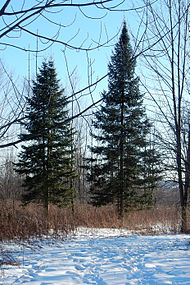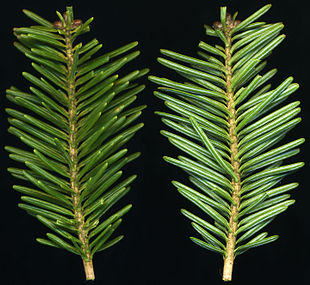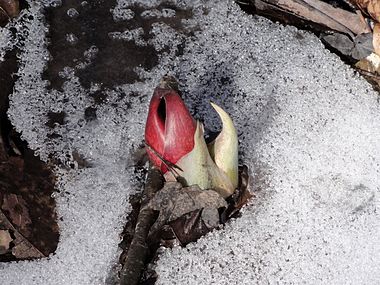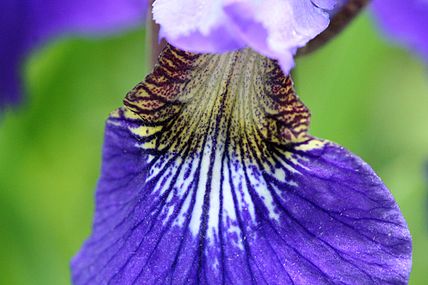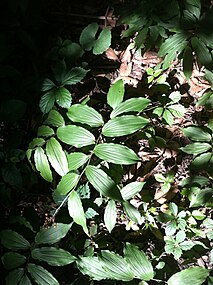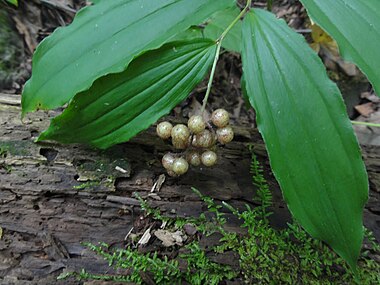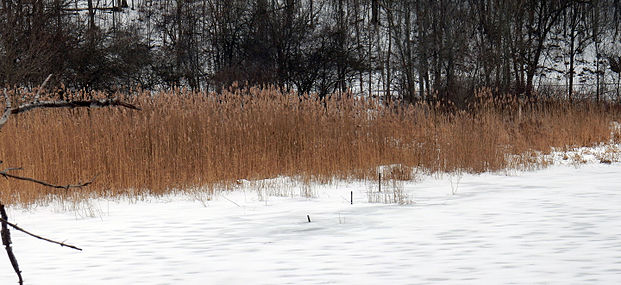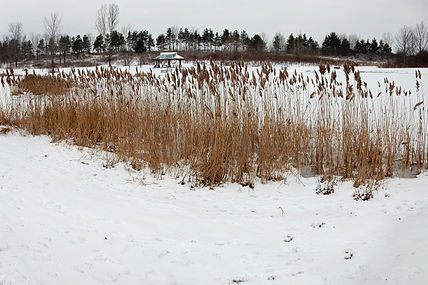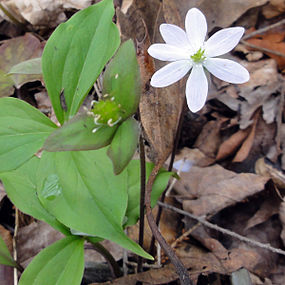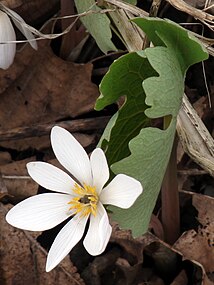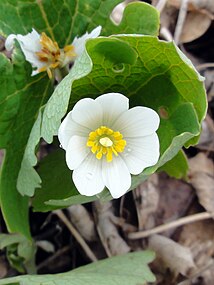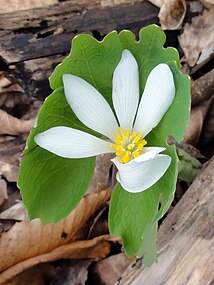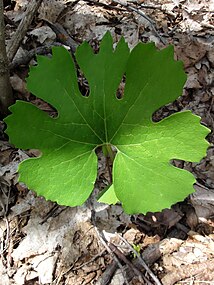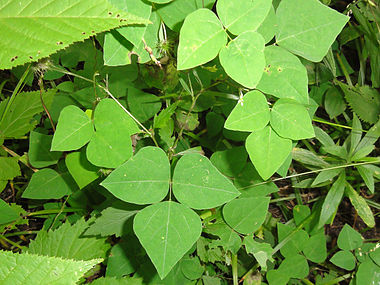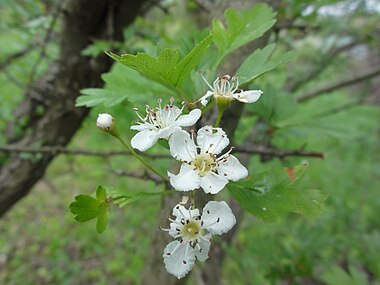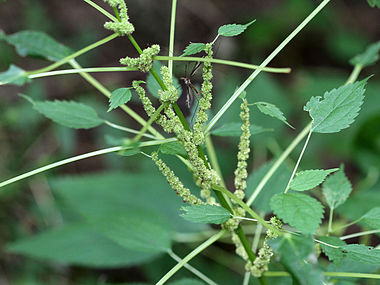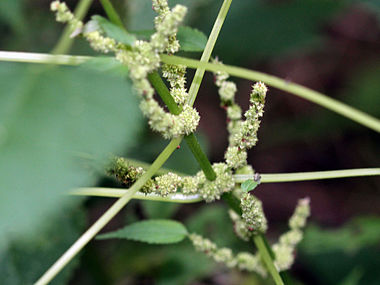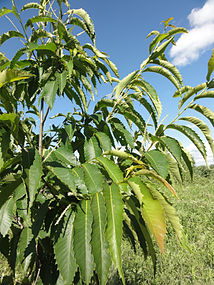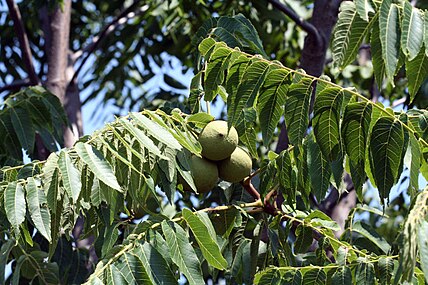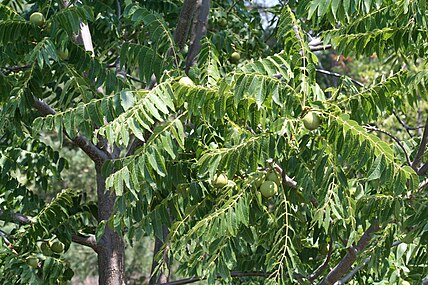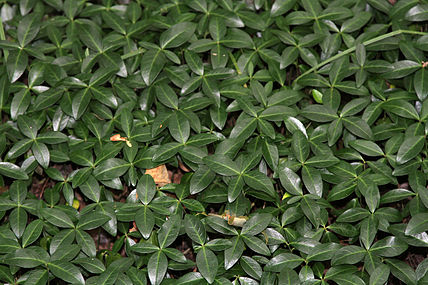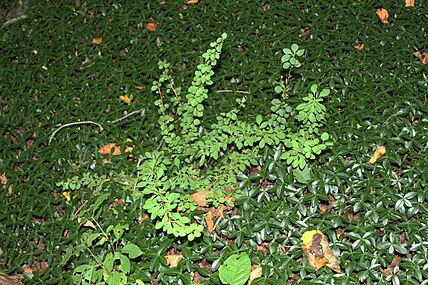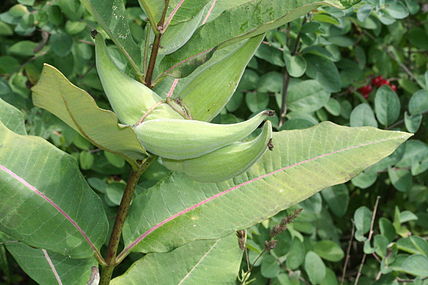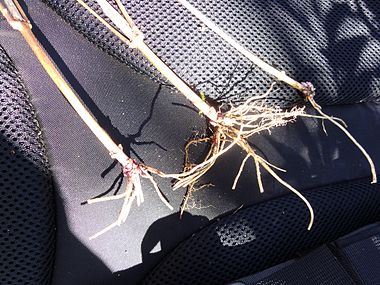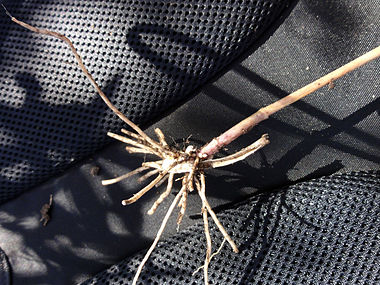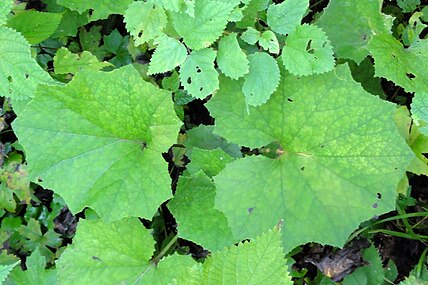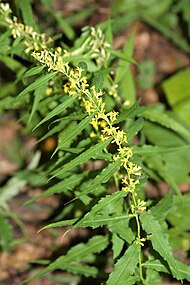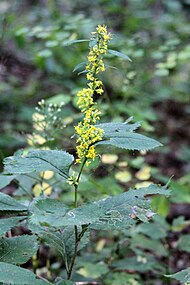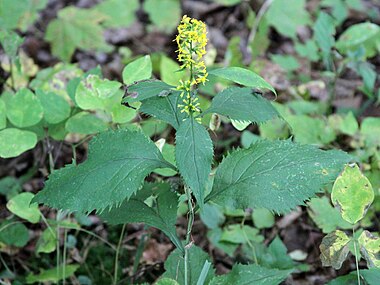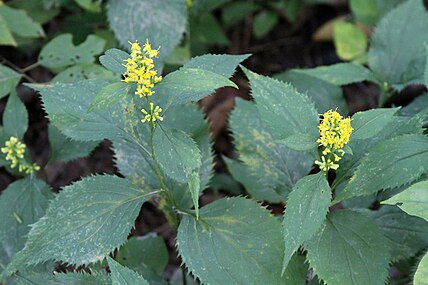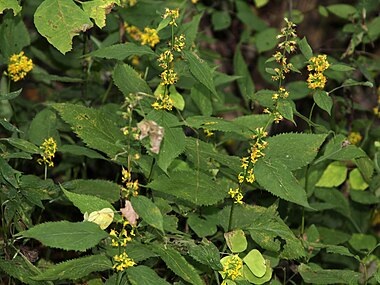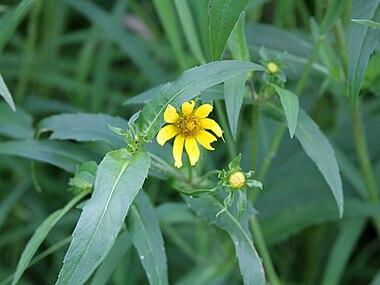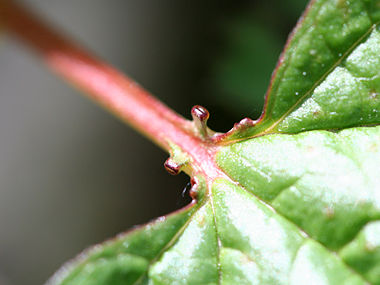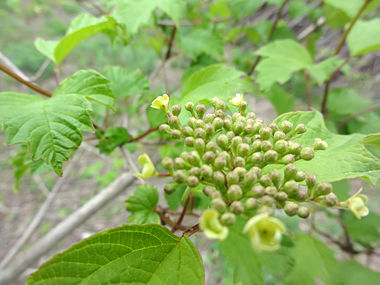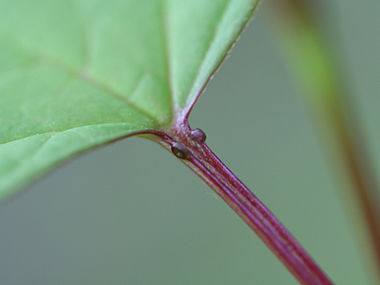Skaneateles Conservation Area flora
Index
[edit]
Pinales: Pinaceae: Pinus sylvestris. These flowering, non-native Scotch pines were apparently planted during the 1970s, above the fishing pond at the Federal Farm.
- Scotch pine, Federal Farm, 14 May 2012.
- Scotch pine, Federal Farm, 14 May 2015.
Pinales: Pinaceae: Abies balsamea, balsam firs, are native conifers.
- Balsam fir, Scout Field, 22 Dec. 2014.
Pinales: Cuprecaceae: Juniperus communis var. depressa, common dwarf juniper, is a native conifer found at various Federal Farm locations.
- Dwarf juniper, January 2012
- Dwarf juniper, May & August 2012
Laurales: Lauraceae: Lindera benzoin, native spicebush is an early sign of Spring along the trail down to the Gully Road beaver pond from the Federal Farm.
- Spicebush, Federal Farm, 21 Apr. 2011.
- Spicebush, Federal Farm, 26 Apr. 2011.
- Spicebush, Federal Farm, 27 Apr. 2011.
- Spicebush, Federal Farm, 2 Sep. 2011.
- Spicebush, Federal Farm, 19 Aug. 2012.
Alismatales: Araceae: Symplocarpus foetidus. native
- Skunk cabbage, Guppy Farm, 13 March 2016.
Alismatales: Araceae: Arisaema triphyllum. native
- Jack-in-the-pulpit, Guppy Farm, above Guppy Falls, 8 May 2011.
- Jack-in-the-pulpit in a Vinca infestation, Guppy Farm, 31 Aug. 2015.
Asparagles: Iridaceae: Iris sanguinea (Japanese Iris) is an introduced wildflower of fields and open wetlands.
- Harlequin blue flag, in Scout Field on the Federal Farm, 7 June 2016.
Asparagles: Asparagaceae: Maianthemum racemosum, false Solomon’s-seal, is a native woodland wildflower.
- False Solomon’s-seal, Guppy Farm, 8 May 2011.
- False Solomon’s-seal, Federal Farm, 15 July 2013.
- False Solomon’s-seal, Guppy Farm, 7 Aug. 2014.
- False Solomon’s-seal, Guppy Farm, 22 Jun. 2015.
- False Solomon’s-seal in a myrtle infestation, Guppy Farm, 15 Sep. 2015.
Asparagles: Asparagaceae: Maianthemum stellatum. A large patch of native Starry Solomon’s-seal was discovered after clearing a thicket of exotic bush honeysuckle from one of the clearings in the woods between the fishing pond and Scout Field. However this patch quickly began to be consumed by pale swallowwort and other weeds.
- Starry Solomon’s-seal, Federal Farm, 8 May 2013.
- Starry Solomon’s-seal, Federal Farm, 19 May 2013.
- Starry Solomon’s-seal, Federal Farm, 29 Jun 2014.
Poales: Typhaceae: Typha latifolia. The native broadleaf cattail is prevalent primarily around the fishing pond on the Federal Farm.
- Broadleaf cattail, Federal Farm fishing pond, 3 Aug. 2012.
Poales: Poaceae: Phragmites australis subsp. australis or European common reed is a highly invasive grass that has infested several wetland areas at the Skaneateles Conservation Area.
- Phragmites, 21 Dec. 2014.
-
near the lower beaver dam along Gully Road
-
across from the pavilion at the fishing pond
- Phragmites behind the transfer station, 26 Dec. 2014.
- Phragmites, across from the pavilion at the fishing pond, 26 Dec. 2014.
- Phragmites, near the southern beaver dam, 31 Oct. 2015.
Ranunculales: Berberidaceae: Berberis thunbergii Japanese barberry, is a very highly invasive shrub that is quite common at the conservation area.
- Japanese barberry. 29 Apr. 2011
- Japanese barberry. 3 May. 2012
- Japanese barberry. 22 Dec. 2014
- Japanese barberry in a Vinca minor infestation, Guppy Farm. 31 Aug. 2015
- Japanese barberry, South end of Federal Farm. 2 Nov. 2015
Ranunculales: Menispermaceae: Menispermum canadense, Canada moonseed, a native vine, along the north-south trail that separates the Federal Farm from the transfer station.
- Canada moonseed, Federal Farm, 14 June 2012.
- Canada moonseed, Federal Farm, 17 Oct. 2012.
Ranunculales: Berberidaceae: Caulophyllum giganteum. A native early spring wildflower.
- Early blue cohosh, east side of the Gully Road beaver pond, 21 Apr. 2011.
- Early blue cohosh, east of beaver pond, 26-29 Apr. 2011.
- Blue cohosh, near Guppy Falls, 7 Aug. 2014.
Ranunculales: Ranunculaceae: Thalictrum thalictroides. A native early spring wildflower. Its leaf-shape is similar to, but much smaller than blue cohosh (Caulophyllum thalictroides).
- Rue anemone, Federal Farm 8 May 2011.
- Rue anemone, Federal Farm 3 Aug. 2012.
Ranunculales: Ranunculaceae: Actaea pachypoda, white baneberry or doll's eyes, is a native woodland wildflower.
- White baneberry, near Guppy Falls, 7 Aug. 2014.
- White baneberry, near Guppy Falls, 22 Jun. 2015.
Ranunculales: Ranunculaceae: Caltha palustris. These native marsh marigolds were in the bog on the west side of the beaver pond along Gully Road,
- Marsh marigold, 29 Apr. 2011.
Ranunculales: Ranunculaceae: Anemone acutiloba, sharp-lobed hepatica, is a native, early-Spring woodland wildflower.
- Sharp-lobed hepatica, O'loughlin Tract, 26 Apr. 2011.
Ranunculales: Ranunculaceae: Clematis virginiana. Native Virgin's-bower vines were growing on exotic honeysuckle bushes on the west edge of scout field until the bushes were removed over the winter of 2014 and 2015.
- Virginia virgin's-bower, Scout Field, 14 Jun. 2012.
- Virginia virgin's-bower, Scout Field, 11 Aug. 2014.
- Virginia virgin's-bower, Scout Field, 16 Aug. 2014.
- Virginia virgin's-bower, Scout Field, 22 Aug. 2014.
- Virginia virgin's-bower, Scout Field, 28 Aug. 2015.
- Virginia virgin's-bower, clearing in woods south of fishing pond, Federal Farm, 11 Sep. 2015.
- Virginia virgin's-bower, farther south on Scout Field, 3 Oct. 2015.
- Virginia virgin's-bower, clearing in woods south of fishing pond, 3 Oct. 2015.
- Virginia virgin's-bower, clearing in woods south of fishing pond, 2 Nov. 2015.
Ranunculales: Ranunculaceae: Sanguinaria canadensis. Bloodroot is a native, early-Spring woodland wildflower. It derives its name from the deep red, caustic sap the flows through its roots.
- Bloodroot, Spring 2011.
-
17 Apr. 2011.
-
25 Apr. 2011.
-
25 Apr. 2011.
-
26 Apr. 2011.
-
8 May 2011.
Saxifragales: Hamamelidaceae: Hamamelis virginiana, American witch-hazel, is a native understory tree.
- American witch-hazel, Guppy Farm, 22 Jun. 2015
- American witch-hazel, Guppy Farm, 22 Aug. 2015
Malpighiales: Salicaceae: Populus deltoides, eastern cottonwood, is a large native tree in the poplar genus, with triangular leaves.
- Eastern cottonwood catkins, at the Federal Farm parking lot on Old Seneca Turnpike, 19 May 2013.
Malpighiales: Salicaceae: Salix matsudana, corkscrew willow is a non-native tree from Asia, occasionally used for marsh restoration or as an ornamental tree. These trees rarely if ever naturalize in this area, so this one is assumed to have been planted.
- A corkscrew willow, at the fishing pond 19 May 2013.
Fabales: Fabaceae: Amphicarpaea bracteata. The American hog peanut is a native herbacious twining vine that is found climbing shrubs, grape vines, and goldenrod along mostly-wooded trails in the Federal Farm, It flowers in late August. It is closely related to the highly invasive kudzu (Pueraria montana), an Asian vine which hasn't been know to naturalize in this vicinity as of yet.
- American hog peanut, Federal Farm, 26 Aug. 2015.
- American hog peanut, Federal Farm, 28 Aug. 2015.
Fabales: Fabaceae: Lotus corniculatus. Bird's-foot trefoil is a common exotic and moderately invasive weed in the fields of the Federal Farm.
- Bird's-foot trefoil, Federal Farm. 2 Jul. 2012.
Fabales: Fabaceae: Melilotus albus. White sweetclover is a biennial forage crop that is native to Eurasia and has become a widespread weed in disturbed sites like the Federal Farm, It moves in quickly when other invasive plants are removed from an open area. Some sources treat Melilotus albus as conspecific with Melilotus officinalis, yellow sweetclover, but others have found them to be incompatible.
- White sweetclover, west of the fishing pond on the Federal Farm, 24 Aug. 2015.
Fables: Fabaceae: Vicia cracca, bird vetch, is considered to be moderately invasive in New York State.
- Bird vetch, Federal Farm, 27 Jun. 2012
Allegheny blackberry
[edit]Rosales: Rosaceae: Rubus allegheniensis, Allegheny blackberry, is a native blackberry, common along lightly-shaded woodland trails.
- Allegheny blackberry, Federal Farm, 27 Jun. 2012.
- Allegheny blackberry, Federal Farm, 19 Aug. 2012.
English hawthorn
[edit]Rosales: Rosaceae: Crataegus monogyna. There are about 50 taxa of hawthorns listed in New York State (including some subspecies and hybrids). Of these, only Crataegus monogyna is not native to the Northeast, and it seems to be the most common hawthorn species found at the conservation area.
- English hawthorn, Federal Farm, 3 May, 2012.
- English hawthorn, Federal Farm, 14 May, 2012.
- English hawthorn, Federal Farm, 17 March 2014.
Small-spike false nettle
[edit]Rosales: Urticaceae: Boehmeria cylindrica, small-spike false nettle, is a native wetland plant, similar to the American stinging nettle (Urtica dioica) without the stinging hairs.
- Small-spike false nettle, Guppy Farm, 3 Sep. 2015.
- Small-spike false nettle, Guppy Farm, 15 Sep. 2015.
One-seeded burr-cucumber
[edit]Cucurbitales: Cucurbitaceae: Sicyos angulatus, one-seeded burr-cucumber, is a native vine.
- One-seeded burr-cucumber, near the landfill, 7 Sep. 2015.
White oak
[edit]Fagales: Fagaceae: Quercus alba, white oak, a native tree.
- A young white oak near the fishing pond. 26 Oct. 2015.
Fagales: Fagaceae: Quercus rubra, red oak, a native tree.
- An old red oak that lost a large branch. 29 Sep. 2012.
- Same red oak. 9 Nov. 2015.
American chestnut
[edit]Fagales: Fagaceae: Castanea dentata. These native, pure American chestnut trees were planted sometime around 2003. The year 2012 appears to be the only time that they flowered and produced nuts. Most of the original trees have died, but a few are left and others have been planted.
- American chestnut, Federal Farm, 26 Jun. 2012.
- American chestnut, Federal Farm, 27 Jun. 2012.
- American chestnut, Federal Farm, 11 Oct. 2012.
- American chestnut, Federal Farm, 13 Oct. 2012.
- American chestnut, Federal Farm, 17 Oct. 2012.
Black walnut
[edit]Fagales: Juglandaceae: Juglans nigra. This is the native black walnut tree on the east side of the observation deck on the Federal Farm.
- Black walnut, 3 Aug. 2012.
- Black walnut, 17 Oct. 2012.
- Black walnut, 2 Aug. 2014.
- Black walnut, 6 Oct. 2014.
Myrtales: Lythraceae: Lythrum salicaria, purple loosestrife is is found in many sunny wetland areas at the SCA.
- Lythrum salicaria in dry field behind transfer station hard-fill area, 19 Aug 2012. iNat Obs
- Lythrum salicaria in wetland (dried-up beaver pond) on Gully Road, 31 Jul 2016. iNat Obs
- Lythrum salicaria in wetland (dried-up beaver pond) on Gully Road, 7 Aug 2016. iNat Obs
- Lythrum salicaria in rehydrated beaver pond on Gully Road, 31 Aug 2018. iNat Obs
Bladdernut
[edit]Crossosomatales: Staphyleaceae: Staphylea trifolia. The Native bladdernut shrubs are common along the edges of wooded areas at the Federal Farm.
- Federal Farm, 14 Jun. 2012.
- Federal Farm, 19 May 2013.
- Federal Farm, 11 Jul. 2013.
- Federal Farm, 9 Nov. 2014.
Staghorn sumac
[edit]Sapindales: Anacardiaceae: Rhus typhina, staghorn sumac, is a small Native tree, common on roadsides and forest edges.
- Staghorn sumac tree, 26 Dec. 2014.
- Staghorn sumac fruit, 24 Aug. 2015.
These staghorn sumac leaves are hosting Melaphis rhois (staghorn sumac aphid) galls. The tree is located on the edge of a clearing in the woods just south of the fishing pond on the Federal Farm, 28 Aug. 2015.
- Staghorn sumac with aphid galls, 28 Aug. 2015.
- Staghorn sumac fruit, 11 Sep. 2015.
- Staghorn sumac tree, 26 Oct. 2015.
Poison ivy
[edit]Sapindales: Anacardiaceae: Toxicodendron radicans. Native but poisonous.
- Enveloping a buckthorn tree above the fishing pond on the Federal Farm, 13 Jun. 2012.
- Poison ivy roots, Federal Farm, 8 Nov. 2012.
- Scout Field, 5 Nov. 2015.
- First two steps on the trail to Guppy Falls, 31 Aug. 2015.
Striped maple
[edit]Sapindales: Sapindaceae: Acer pensylvanicum.
American pokeweed
[edit]Caryophyllales: Phytolaccaceae: Phytolacca americana, American pokeweed, is a native, perennial herbaceous plant.
- American pokeweed, Federal Farm, 3 Oct. 2015.
Orange jewelweed
[edit]Ericales: Balsaminaceae: Impatiens capensis, orange jewelweed, is a native plant, common in moist wooded areas.
- Orange jewelweed, Guppy Farm, 31 Aug. 2015.
- Orange jewelweed, on the trail between the Guppy Farm and the Bishop parking lots on Gully Road.
Pale jewelweed
[edit]Ericales: Balsaminaceae: Impatiens pallida, jewelweed, is a native plant common in moist wooded areas.
- Water droplets reflecting white light from jewelweed leaves at the Guppy farm, 22 Jun. 2015.
- Along the gorge bellow Guppy Falls, 16 Aug. 2015.
- On the trail from the Bishop parking on Gully Road to the Guppy Farm, 3 Sep. 2015.
Fragrant bedstraw
[edit]Gentianales: Rubiaceae: Galium triflorum is native woodland Galium species at the Guppy Farm, 24 Aug. 2014
- .
Partridgeberry
[edit]Gentianales: Rubiaceae: Mitchella repens, the native partridgeberry, seems to trive in the shade of hemlocks.
- Partridgeberry, 21-29 Apr. 2011.
- Partridgeberry, 3 May 2012.
- Partridgeberry, 13 Nov. 2014.
Lesser periwinkle
[edit]Gentianales: Apocynaceae: Vinca minor, common periwinkle or myrtle, is an ornamental evergreen ground cover that was imported from Europe in the 1700s. It has escaped cultivation and become quite invasive in the vicinity the old homesteads on the Guppy and O'loughlin properties.
- Lesser periwinkle, Guppy Farm, 8 May 2011.
- Lesser periwinkle, Guppy Farm, 2 Jan. 2015.
- Lesser periwinkle, Guppy Farm, 22 Jun. 2015.
- Lesser periwinkle, Guppy Farm, 18 Aug. 2015.
- Lesser periwinkle, Guppy Farm, 31 Aug. 2015.
Hemp dogbane
[edit]Gentianales: Apocynaceae: Apocynum cannabinum, hemp dogbane, is a native relative of milkweed.
- Hemp dogbane, Federal Farm, 24 Jul. 2011.
Swamp milkweed
[edit]Gentianales: Apocynaceae: Asclepias incarnata. A native milkweed.
- Swamp milkweed near the edge of the lower beaver pond, 31 Oct. 2015.
Common milkweed
[edit]Gentianales: Apocynaceae: Asclepias syriaca, common milkweed and other native milkweeds are larval hosts for monarch butterflies.
- Common milkweed, Federal Farm, 23 Jun. 2012.
- Common milkweed, Federal Farm, 3 Aug. 2012.
-
forma inermis?
Pale swallowwort
[edit]Gentianales: Apocynaceae: Vincetoxicum rossicum, pale swallow-wort is a very highly invasive exotic relative of common milkweed. It has become quite common on the Federal Farm section of the conservation area. Besides enveloping and displacing native plants, it is reported to be attractive to monarch butterflies as an alternative egg-laying site. However, only milkweed species will support the monarch larvae, so eggs deposited on swallowwort are wasted.
- Pale swallowwort, Federal Farm, 24 Jul. 2011.
- Pale swallowwort, Federal Farm, 17 Feb. 2012
- Federal Farm, 14 Jun. 2012.
- Federal Farm, 22 Jun. 2012.
- Federal Farm, 22 Dec. 2014.
- Federal Farm, 25 May 2015.
- Guppy Farm, 31 Aug. 2015.
- Federal Farm, 3 Oct. 2015.
- Federal Farm, 16 Oct. 2015.
- Federal Farm, 23 Oct. 2015.
- Gully Road, across from Guppy Falls parking lot, 31 Oct. 2015.
- Federal Farm, 7 June 2016.
White turtlehead
[edit]Lamiales: Plantaginaceae: Chelone glabra, white turtlehead, is a native wetland plant that flowers in late summer. Wet area on the Guppy Farm red trail and around beaver pond on Gully Road.
- White turtlehead, Guppy Farm, 31 Aug. 2015. Note the powdery mildew on the leaves.
- White turtlehead, Guppy Farm, 3 Sep. 2015. Note the bumblebee and snails.
- White turtlehead, Lower beaver pond boardwalk, 3 Sep. 2016.
Canada horse-balm
[edit]Lamiales: Lamiaceae: Collinsonia canadensis, native.
- Guppy Falls overlook area on the Guppy Farm, 20 Jun. 2015.
- Guppy Farm, 22 Jun. 2015.
- Guppy Farm, 22 Aug. 2015.
Wild basil
[edit]Lamiales: Lamiaceae: Clinopodium vulgare, native (circumboreal) weed.
- Wild basil, Scout Field on the Federal Farm, 28 Aug. 2015.
Self-heal
[edit]Lamiales: Lamiaceae: Prunella vulgaris, self-heal, is a widespread weed. It seems possible based on leaf shape that these are the native var. lanceolata plants rather than the more common Eurasian var. vulgaris.
- Self-heal, Federal Farm, 3 Jul. 2012.
- Self-heal, Federal Farm, field above fishing pond, 28 Aug. 2015.
Bluntleaf waterleaf
[edit]Boraginales: Boraginaceae: Hydrophyllum canadense, Bluntleaf waterleaf, is a native woodland ground cover.
- Bluntleaf waterleaf, Guppy Farm, 20 Jun. 2015.
- Bluntleaf waterleaf, Guppy Farm, 12 Aug. 2015.
- Bluntleaf waterleaf, Guppy Falls gorge, 16-19 Aug. 2015.
American winterberry
[edit]Aquifoliales: Aquifoliaceae: Ilex verticillata. A pair of native winterberry bushes (one male and one female) were planted near the pavilion by the fishing pond in the early 2000ies.
- American winterberry, near the fishing pond, 16 Oct. 2015.
- American winterberry, near the fishing pond, 2 Nov. 2015.
Asterales: Campanulaceae: Lobelia cardinalis, cardinalflower is is found occasionally around the beaver pond on Gully Road.
- Cardinalflower, 7 Aug. 2016.
Chicory
[edit]Asterales: Asteraceae: Cichorium intybus, chicory, was introduced from Eurasia. It is a common roadside weed that flowers in late summer. Its roots are the source of the coffee additive of the same name.
- Chicory, Federal Farm, 24 Aug. 2015.
- Chicory, Federal Farm, 28 Aug. 2015.
Asterales: Asteraceae: Tussilago farfara, coltsfoot, is a common non-native weed whose flowers appear in early spring and leaves appear later in the season.
- Coltsfoot, by the bridge below the upper beaver dam, 26 Apr. 2011.
- Coltsfoot, Federal Farm, 3 May 2012.
- Coltsfoot, by the Guppy Falls parking lot, 12 & 16 Aug. 2015.
- Coltsfoot, by the landfill, 7 & 11 Sep. 2015.
- Coltsfoot, in the Guppy Falls parking lot, 15 Sep. 2015.
Blue-stem goldenrod
[edit]Asterales: Asteraceae: Solidago caesia, blue-stem goldenrod, is one of the common native woodland goldenrods at the conservation area.
- Blue-stem goldenrod, Guppy Farm, 24 Aug. 2015.
- Blue-stem goldenrod, Guppy Farm, 15 Sep. 2015.
- Blue-stem goldenrod, Guppy Farm, 20 Sep. 2015.
Zigzag goldenrod
[edit]Asterales: Asteraceae: Solidago flexicaulis, zigzag goldenrod, is another common native woodland goldenrod at the conservation area.
- Zig-zag goldenrod, Guppy Farm, 24 Aug. 2015.
- Zig-zag goldenrod, Guppy Farm, 31 Aug. 2015.
- Zig-zag goldenrod, Guppy Farm, 15 Sep. 2015.
- Zig-zag goldenrod, Guppy Farm, 20 Sep. 2015.
Wrinkled-leaf goldenrod
[edit]Asterales: Asteraceae: Solidago rugosa, wrinkled-leaf goldenrod is a native goldenrod found in both fields and wooded areas.
- Wrinkled-leaf goldenrod at the edge of Scout Field where exotic bush honeysuckle had been cleared the previous year. These photographs were taken 3 Oct. 2015.
White wood aster
[edit]Asterales: Asteraceae: Eurybia divaricata. White wood aster is a native woodland wildflower.
- White wood aster, Federal Farm, 19 Aug. 2012.
- White wood aster, Guppy Farm, 22 Aug. 2015.
Mugwort
[edit]Asterales: Asteraceae: Artemisia vulgaris, mugwort or common wormwood, is considered to be a highly invasive exotic weed.
- Mugwort, Federal Farm, 7 Sep. 2015.
Nodding beggar-ticks
[edit]Asterales: Asteraceae: Bidens cernua , nodding beggar-ticks, are late-summer native wildflowers that appear at water's edges.
- Nodding beggar-ticks, by the Fitzgerald-tract/beaver-dam bridge, 7 Sep. 2015.
- Nodding beggar-ticks, by the lower beaver pond, 21 Jun. 2016.
- Nodding beggar-ticks, by the lower beaver pond, 7 Aug. 2016.
Annual ragweed
[edit]Asterales: Asteraceae: Ambrosia artemisiifolia, annual ragweed, is a native weed that commonly grows on exposed dry soil along roads and agricultural fields. Its pollen is an allergen that is dispersed by the wind and partly to blame for the bad reputation of goldenrod whose pollen is too large to be allergenic.
- Ragweed, Federal Farm, 19 Aug. 2012.
- Ragweed, Federal Farm, 4-6 Aug. 2014.
White snakeroot
[edit]Asterales: Asteraceae: Ageratina altissima. White snakeroot is a toxic native woodland plant that is the source of "milk sickness" when consumed by cattle. It is a very common late summer wildflower in the more-wooded parts of the conservation area.
- White snakeroot at the Guppy Farm, 3 Aug. 2012.
- White snakeroot at the Federal Farm, 19 Aug. 2012.
- White snakeroot at the Guppy Farm, 31 Aug. 2015.
- White snakeroot at the Guppy Farm, 3 Sep. 2015.
Common boneset
[edit]Asterales: Asteraceae: Eupatorium perfoliatum, common boneset, is a native plant that is common in old fields.
- Common boneset, Federal Farm, 2 Aug. 2014.
- Common boneset, Federal Farm, 24 Aug. 2015.
- Common boneset, Federal Farm, 28 Aug. 2015.
Nannyberry
[edit]Dipsacales: Adoxaceae: Viburnum lentago, nannyberry, is a native shrub or small tree.
- Federal Farm, above the fishing pond, 14 May 2012.
- Federal Farm, above the fishing pond, 17 Oct. 2012.
- Federal Farm, center trail, 3 Oct. 2015.
Hobblebush
[edit]Dipsacales: Adoxaceae: Viburnum lantanoides, hobblebush, is a native shrub.
- Near beaver pond on Gully Road, 7 Aug. 2016.
Cranberry-bush viburnum
[edit]Dipsacales: Adoxaceae: Viburnum opulus. Cranberry-bush viburnum (also called guelder-rose or highbush cranberry) is quite plentiful on the Federal Farm section of the conservation area. It often grows along with the even-more plentiful exotic bush honeysuckle (Lonicera spp.) and when only the stems are observed they can be easily mistaken for honeysuckle. Although there are native cranberry-bush viburnums (Viburnum trilobum = Viburnum opulus var. americanum = Viburnum opulus ssp. trilobum), ours all appear to be V. opulus var. opulus, the European variety. We have not discovered any with petiole glands that are consistently stalked and convex, which would indicate the native variety.
- Field south of transfer station at the Federal Farm, 10 June 2011.
- Field south of transfer station at the Federal Farm, 24 Jul. 2011.
- Field south of transfer station at the Federal Farm, 2 Sep. 2011.
- Field south of transfer station at the Federal Farm, 1 Jan. 2012.
- Cranberry-bush viburnum, Federal Farm, 2012.
-
30 Apr.
-
12 May
-
12 May
-
12 May
-
14 May
-
7 Jun.
-
2 Jul.
-
2 Jul.
-
3 Aug.
- Federal Farm, 2015.
-
25 May
-
11 Sep.
-
19 Oct.
-
19 Oct.
American black elderberry
[edit]Dipsacales: Adoxaceae: Sambucus nigra subsp. canadensis, American black elderberry, is a native shrub.
- American black elderberry, near the fishing pond on the Federal Farm, 6 Jul. 2015.
- American black elderberry, near the fishing pond on the Federal Farm, 24 Aug. 2015.
- American black elderberry, near the fishing pond on the Federal Farm, 11 Sep. 2015.
- American black elderberry, near the beaver pond on Gully Road, 7 Aug. 2016.
Orange-fruited horse gentian
[edit]Dipsacales: Caprifoliaceae: Triosteum aurantiacum, orange-fruited horse gentian, is a native plant, also known as wild coffee and coffee tinker's weed.
- Orange-fruited horse gentian, Federal Farm, 9 Nov. 2014.
- Orange-fruited horse gentian, Federal Farm, 7 Sep. 2015.
- Orange-fruited horse gentian, Federal Farm, 11 Sep. 2015.
Wild fuller's teasel
[edit]Dipsacales: Caprifoliaceae: Dipsacus fullonum, is a non-native weed that is common in the area.
- Fuller's teasel, Federal Farm, 3 May 2012.
- Fuller's teasel, by beaver pond on Gully Road, 31 Oct. 2015.








